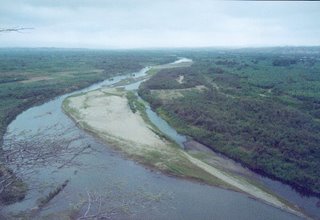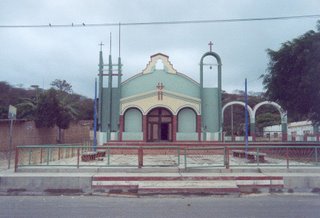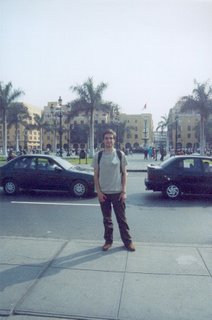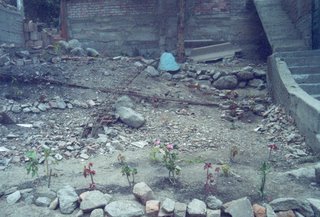FEBRUARY

25. Febrero. 2007. 7:20 a.m.
"¡Cangrejos! ¡Cangrejos! ¡Can-can-can-grejos!" shouted the street vendor as I approached the house after my morning run. He was carrying straw baskets filled to capacity with the purple-electric orange-colored sea crabs, most of whom were still alive, tied up into neat bundles and ready for sale. They were probably caught in the pre-dawn Pacific this morning and brought fresh into town. After a near sleepless night (malaria meds?), I somehow found the energy to embark on my first early morning run since I´ve been here, which offered me another new glimpse of the town where I live. It is peaceful to be up before the rest of the town, finding few passerbys on the street or in the plaza, and the majority of the vicious street dogs still laying harmlessly in doorways and on heaps of dirty fertilizer sacks and gravel. In a few hours my friend Lauren (PCV from a nearby town) will come by to teach me how to do PowerPoint (cringe!) so that we can prepare for an upcoming 3-month review of our work in site, to be presented in Trujillo. 3 months in-site! Time marches forward.
This month presented another set of challenges: nearing completion and mainting student motivation for the World Map Project at a local high school (pictured), more consults and referrals at my health post for mental health needs in our underserved community, putting together the data from the community health diagnostic in January, two radio interviews on the local wave and a montón of birthdays that I missed stateside, among friends and family... (¡Feliz Días Rybz, Bri, Dad!)
Some new ideas I´ve had include helping to organize efforts around building a shelter in or around my community for women suffering from the effects of violencia familiar and abuse. Most other departments (states) here already have Casitas de Refugio while in the north we seem to be behind the curve when it comes to some basic social support services and networks. There are grants and funding (national and international) that can be utilized with the proper coordination. I have had some good collaborations of late, meeting two psychologists in my area who are helping to familiarize me with the Peruvian system amidst extremely busy schedules. One psychologist has already secured the funds and resources from the regional health headquaters and a cooperating Spanish government agency for a two-day capacity-building workshop on Alcoholism and Substance Abuse- Best Treatment Practices... which I have agreed to help organize and carry out. Vamos a ver. Some other activities with my health post have included visiting the tiendas and kioskos in a nearby town to check expiration dates on the food being sold. I am also getting alot of pressure to start an English class (realistically,March or April) and am starting to begin some planning and coordination with local schools for health talks and courses during the upcoming school year amidst the challenges of differences in local politics and challenges in organization and communication between organizations and different institutions. I also started to teach a one person class on basic internet skills, aprovechando the plethora of internet cabinas in my little town.
As the temperature continues to climb here (90s instead of 80s) I look forward to a trip to my "reconnect" next month which is an opportunity to reunite and present our work with other volunteers from the same volunteer cycle after 3 months of service. The trip will give everyone a breather from their sites and in my case, a relief from the heat.
Carnival is still in full swing through February and I´ve been soaked a number of times over the past few weeks by girls armed with water balloons or huge buckets of water. My "host cousin" dunked me in a baby pool last Sunday, destroying my Sunday Edition of El Comercio... Ergh. The mototaxistas get it alot worse than I do though-- I feel for them, but then I remember how many times I´ve almost been hit trying to cross the street here due to their crazy driving! Other fun stuff has been making a spaghetti dinner with garlic bread for my host brothers while watching episodes of The Simpson´s and Alf, both of which are favorites on the television here. In closing, a short quote from the legendary British singer-songwriter,
"I wanted to be the one with road dust on my boots. And a single silver earring and a suitcase full of notes." -- Vashti Bunyan, Lookaftering
Can you say Lord Stanley Cup?
I Love You,
MM









